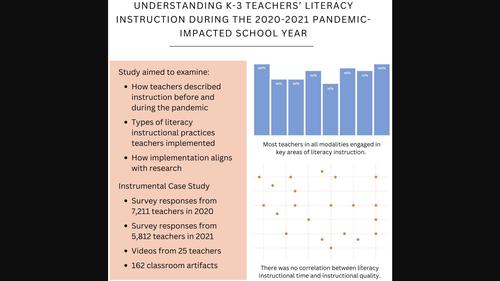了解 K-3 教师在 2020-2021 学年受大流行病影响期间的识字教学实践
IF 4.1
1区 教育学
Q1 EDUCATION & EDUCATIONAL RESEARCH
引用次数: 0
摘要
这项工具性案例研究的重点是进一步了解 2020-2021 学年受大流行病影响的 K-3 课堂中的识字教学。研究旨在考察:(a) 在 COVID-19 大流行之前和期间,教师如何描述他们的识字教学;(b) 教师在面对面、虚拟和混合模式下实施的识字教学实践类型;(c) 教师实施这些实践的情况如何与低年级识字教学研究相一致。数据包括 25 位教师的识字教学课堂视频、162 份课堂作品(如学生作业样本),以及来自 2020 年春季 7110 位教师和 2021 年春季 5811 位教师的全州调查反馈。据教师们报告,与大流行前的典型学年相比,2020-2021 学年每周用于扫盲教学的时间平均减少了 1 小时。尽管报告的教学时间有所减少,但观察到所有模式的教师实施扫盲教学实践的比例与大流行前相当。然而,教师们的实施情况却大相径庭,有些教师提供了与研究相一致的扫盲教学,而有些教师则没有。这种质量上的差异在不同的教学模式中都很明显,包括在提供面对面教学的教师群体中。这项研究的结果对现有的关于教学时间和教学模式的理论提出了挑战,这些理论被用来解释大流行病对小学生识字成果的负面影响。本文章由计算机程序翻译,如有差异,请以英文原文为准。

Understanding K-3 Teachers' Literacy Instructional Practices During the Pandemic-Impacted 2020–2021 School Year
This instrumental case study is focused on understanding more about literacy instruction in K-3 classrooms during the pandemic-impacted 2020–2021 school year. The study aims to examine (a) how teachers described their literacy instruction before and during the COVID-19 pandemic; (b) the types of literacy instructional practices teachers implemented across in-person, virtual, and hybrid modalities; and (c) how teachers' implementation of these practices aligns with research on early grades literacy instruction. Data included classroom video of 25 teachers' literacy instruction, 162 classroom artifacts (e.g., student work samples), and statewide survey responses from 7110 teachers in spring 2020 and 5811 teachers in spring 2021. Teachers reported spending an average of 1 h less per week on literacy instruction in 2020–2021 as compared to a typical pre-pandemic school year. Despite these reported declines in instructional time, teachers in all modalities were observed implementing literacy instructional practices at comparable rates as they reported prior to the pandemic. However, teachers' implementations of these practices varied widely, with some teachers providing research-aligned literacy instruction while others did not. This range in quality was evident across modalities, including within the group of teachers providing in-person instruction. Results from this study challenge existing theories about instructional time and modality that have been posed to explain the pandemic's negative impacts on elementary students' literacy outcomes.
求助全文
通过发布文献求助,成功后即可免费获取论文全文。
去求助
来源期刊

Reading Research Quarterly
Multiple-
CiteScore
10.50
自引率
4.80%
发文量
32
期刊介绍:
For more than 40 years, Reading Research Quarterly has been essential reading for those committed to scholarship on literacy among learners of all ages. The leading research journal in the field, each issue of RRQ includes •Reports of important studies •Multidisciplinary research •Various modes of investigation •Diverse viewpoints on literacy practices, teaching, and learning
 求助内容:
求助内容: 应助结果提醒方式:
应助结果提醒方式:


